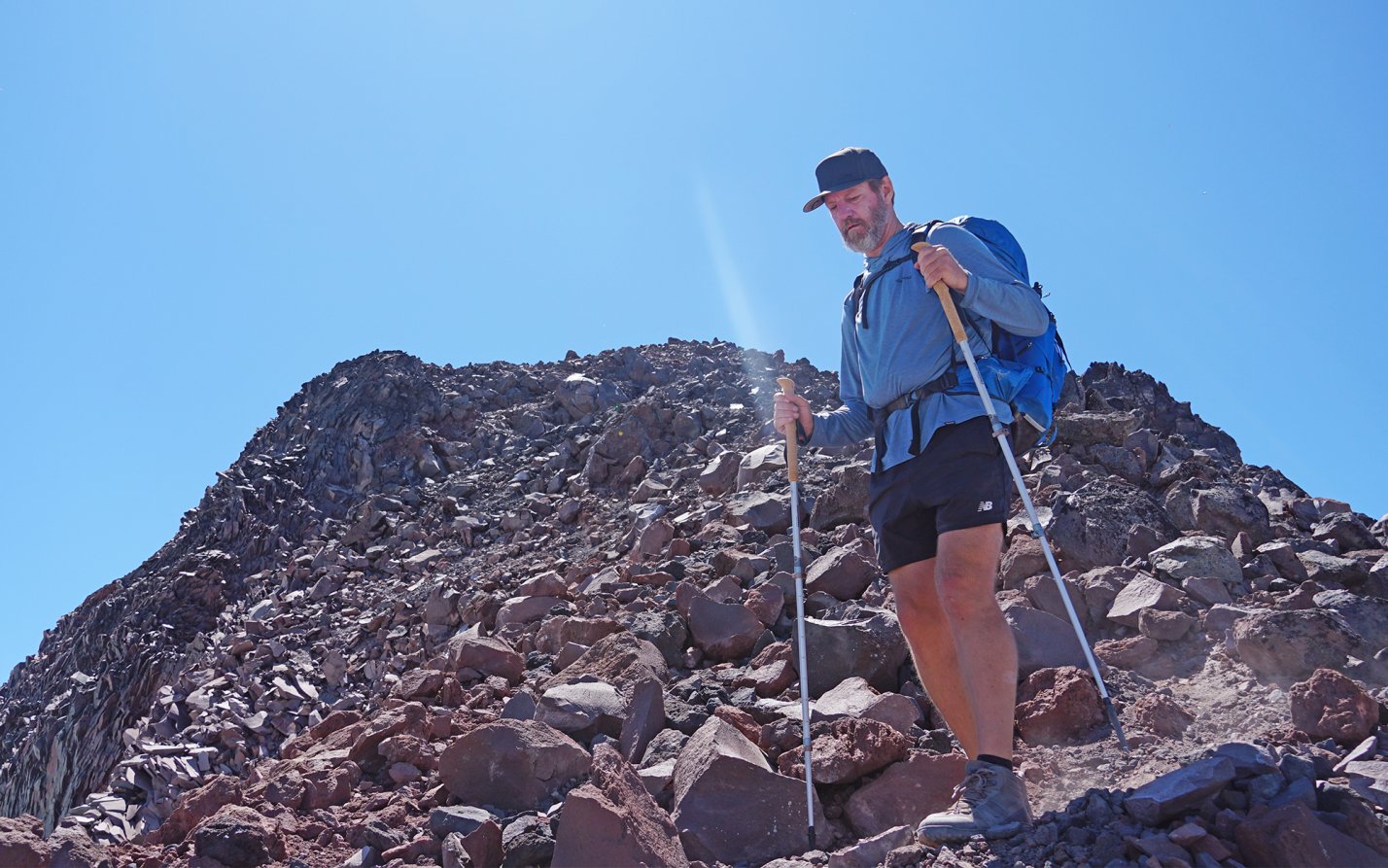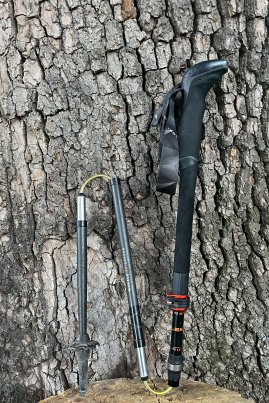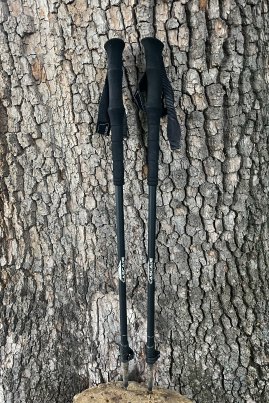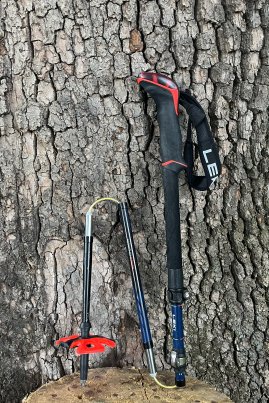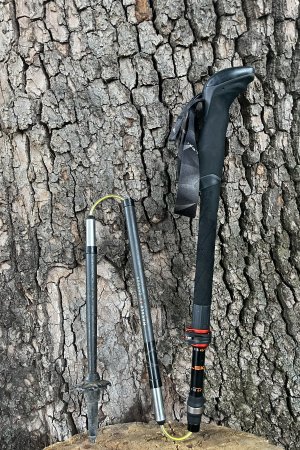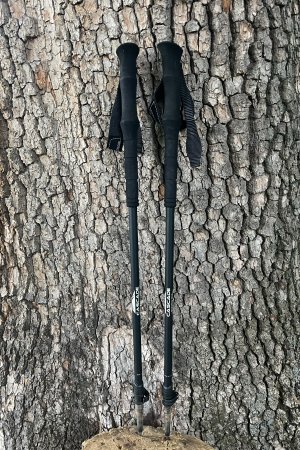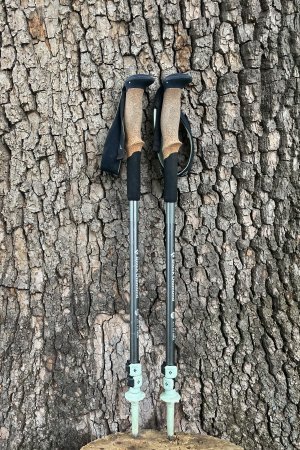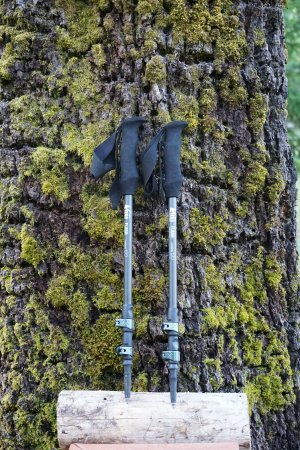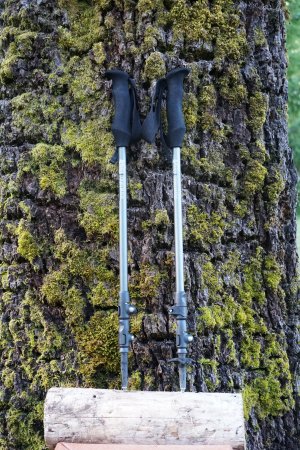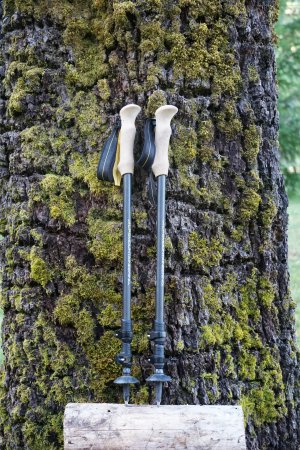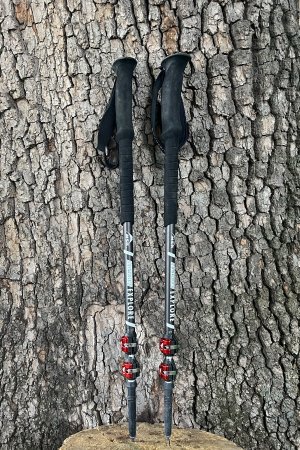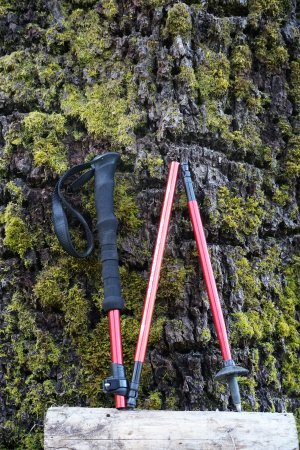We may earn revenue from the products available on this page and participate in affiliate programs. Learn More ›
Trekking poles give you more stability on consequential terrain like scree, boulder fields, and fast river crossings. They can also help you walk a little faster, their momentum putting you in a hiking flow state. If you have knee, back, or ankle pain, trekking poles can also protect your joints. The extra stability and weight distribution of trekking poles alleviates stress on your body, and makes you a more efficient hiker. We tested the best trekking poles as part of Outdoor Life’s annual backpacking gear tests in Oregon and Washington; here they are in order of how highly we recommend them.
- Best Overall: Leki Makalu FX Carbon
- Best Value: Cascade Mountain Tech Ultralight Carbon Fiber 2 Section Quick Lock
- Best for Winter: Leki Sherpa FX Carbon
- TSL Connect Carbon 5 Cross
- Komperdell Explorer Contour Cork
- Black Diamond Pursuit Shock
- REI Flash Carbon
- REI Trailmade
- Alps Mountaineering Alliance
- MSR Dynalock Explore Backcountry Poles
- Alps Mountaineering Conquest
- Gossamer Gear LT5 Carbon
- How to Choose the Best Trekking Poles ↓
- Using Trekking Poles Efficiently ↓
How We Tested the Best Trekking Poles

Outdoor Life conducts an annual backpacking gear testing trip that focuses on innovative lightweight and ultralight backpacking gear. These testing trips take place on America’s national scenic trails, including a 30-mile stretch of the northernmost section of the Oregon Coast Trail and a 40-mile stretch along the Pacific Crest Trail in the Goat Rocks Wilderness. Usually the testing group covers 10 or more miles each day.
Eight testers hiked with the best trekking poles in a range of conditions. In Oregon we traversed sand dunes, flat packed sand beaches, 1,200 vertical feet of mud, and a semi-destroyed section of trail. On our Washington trip, we climbed through the Goat Rocks Wilderness using our poles to navigate snowfields, 2,000-foot passes, and loose shale.
This allowed us to test the stability, grip, and traction of each pair. Having multiple testers means we had multiple opinions and hiking styles to push each pole’s limits. The varying terrain also gave us a good idea of how these poles perform in different places. We also used them to pitch trekking pole tents at the end of the day and relied on them to keep us sheltered through the night.
Best Trekking Poles: Reviews & Recommendations
Best Overall: Leki Makalu FX Carbon
Pros
- Most sturdy
- Extended grip
- Skinny
Cons
- Expensive
- Grips can impart black marks on your hand
Key Features
- Carbon fiber
- Grip: Foam
- Collapsed Length: 15.7 inches (40 centimeters)
- Max Extension: 51 inches (130 centimeters)
- Weight: 1 pound, 2 ounces
- Price: $230
These are the poles I want for consequential terrain, high mileage days, and everything in between. If you do a lot of hiking or backpacking, the Leki Makalu FX Carbon are the best poles to buy. They are one of the heaviest poles in the test, but I trust them completely with all my weight. I also love how skinny and unobtrusive they are. The Makalus feel perfectly balanced in a hiking flow state, their heft providing some momentum with each swing. The lightweight carbon fiber construction and hollow handle still provide plenty of weight savings.

The ergonomic grip is 11 inches long with room to adjust your grip to the steepness of the terrain. The feel of the grip was also my favorite in the test: the light foam layer feels soft, but the grip is firm. Though, sometimes on longer trips, the grips can leave black marks on your hands.
To put these poles together, extend the telescoping portion from the adjustable top section. Connect the bottom three pieces, and give it a considerable tug to lock the lower portion. Then you can adjust the upper shaft to your desired height. The wrist strap securely locks, so the fit won’t change when you press down with your arm or catch the strap on a branch.
The Leki poles did get sand stuck inside the upper shaft, causing small scratches and abrasions on the two upper portions. While this is purely aesthetic, with such an expensive set of trekking poles, you’d think they’d have a tougher paint job. This sand could cause resistance when extending your poles later, so use this as a warning sign to wipe down your poles before storing.

If you’re using the Makalu FX Carbons to construct a trekking pole tent, the measurement ticks include both centimeters and inches, which can come in handy if your shelter instructions only give one measurement. These are the ultimate trekking poles for any dedicated hiker, or hunter.
While mountain hunters have been known to use the legs of their shooting tripod as hiking poles, shooting editor John Snow took the Makula FX Carbons on an elk hunt and was impressed by how light, durable, strong, and comfortable they were for serious climbing with a heavy pack. They served double-duty as a shooting support and propping things up around camp, too. While Leki’s Sherpa’s are my favorite for winter, the Makulas still perform well in cold conditions, and Snow thought they easily adjusted on the fly for steep descents. It’s a do-it-all pair of poles for intense outdoor pursuits, and reliability on shorter adventures.
Best Value: Cascade Mountain Tech Ultralight Carbon Fiber 2 Section Quick Lock
Pros
- Good price
- Four different tip attachments
- Extended grip
Cons
- Longest collapsed length
- Too light
Key Features
- Carbon fiber
- Grip: EVA foam
- Collapsed Length: 30 inches (76 centimeters)
- Max Extension: 52 inches (132 centimeters)
- Weight: 10.2 ounces
- Price: $65
I’ve tried budget trekking poles before; you know the $20 ones on Amazon, and they couldn’t handle my weight, telescoping shorter and shorter every time I actually relied on them. Don’t waste your time on no-name budget trekking poles. If you’re looking for a good value, start with these ultralight carbon fiber trekking poles from Cascade Mountain for $65. The first time one of our testers tried these, they did collapse under pressure, but all she had to do was open the lock, turn the tension knob, and re-lock the poles for reliable stability. There’s also only one flip-lock, so there’s less chance for failure.

They come with four different attachments designed for different terrain: snow baskets, trekking baskets, and rubber boots and rubber tips for walking indoors, on pavement, or protecting the tips while traveling or storing. Testers loved the lightweight, 10.5-inch extended grip, and comfortable wrist strap.
These do have the longest collapsed length, so they don’t store as small as others on this list. The Cascade Mountain poles are also too lightweight for my taste. I like some heft to get momentum when hiking, make me feel comfortable putting my weight on them, and stay controlled in high water. But if you’re looking for a budget option for relaxed hiking or a short trip, these will do the trick.
Best for Winter: Leki Sherpa FX Carbon
Pros
- Durable
- Lightweight
- Ergonomic grip
Cons
- Price
Key Features
- Aluminum lower and carbon fiber upper
- Grip: Aergon air foam
- Collapsed Length: 16 inches (41 centimeters)
- Max Extension: 51 inches (130 centimeters)
- Weight: 1 pound, 1 ounce
- Price: $220
I reviewed the Sherpas independently of the backpacking gear tests, because testing called for snow. I took them ski touring all winter in Utah. Honestly, I was nervous to ski with these poles at first. I assumed the collapsible design would be less structurally sound than a cohesive ski pole. But once I saw the untouched powder below me, I completely forgot to be more careful with them. They stood up to all of the abuse I put them through this ski season: putting all my weight on them to navigate uphill, catching on trees, skidding across bulletproof ice, and post-holing into deep snow.


This stellar durability is thanks to the construction. The lower portion of the poles is sturdy aluminum, while the upper shaft is made of lightweight carbon fiber. The Sherpa’s come with a generously wide powder basket and a comfortable grip. I feel secure holding these poles with my bare hands or thick leather ski gloves. The inclined grip allows for optimal pole placement to achieve that flow state on the up while the locking strap and rubberized grip back decrease the chance you’ll lose a pole on the down.
I also love that the basket has some flex to it so it isn’t likely to break off, but it’s still rigid enough to scrape snow off your skins or flip up a heel riser. While they’re the optimal ski touring, snowshoeing, and winter hiking pole, there’s no reason you can’t use them all summer, too. It’s a sturdy do it all pole backed by Leki’s one year warranty on broken shafts.
TSL Connect Carbon 5 Cross
Pros
- Longest grip
- Include snow and trekking baskets as well as a new crossover tip
- Thin
Cons
- Awkward wrist strap
Key Features
- Carbon fiber
- Grip: EVA foam
- Collapsed Length (Measured): 17 inches (44 centimeters)
- Max Extension: 51 inches (130 centimeters)
- Weight: 1 pound, 1 ounce
- Price: $180
The TSL Connect Carbon 5 Cross has a 14-inch grip giving you plenty of places to grab your pole while sidehilling, ascending, and descending. The external locks, flick lock, and Z pole design is the same as the Leki’s, providing more stability than twist-lock and dual flip-lock models. These poles feel sturdy and reliable and were second only to the Leki Makalus.
TSL poles now come with a crossover tip. It has 8 feet designed to flex and grip with whatever terrain it encounters. They settle on top of gravel and loose rock well and would be great on ice. However, they do slightly increase the length of your pole so I made a micro adjustment to shorten mine when using the crossover tip. It also makes hiking with poles significantly quieter.
The wrist strap locks into the handle via a magnetic attachment that is operated by a large protruding button at the top. If you want to take the wrist strap off entirely, you can press the button on top of the handle to detach it. The strap is long with a large buckle and the excess strap feeds through to form two loops. The loops are clunky and the magnet attachment point is inconveniently placed exactly where I want to put my hand, but you can get used to it.
Testers ended up using the button more as a fidget toy while hiking. Some testers were wary about the button — it sticks out — so it could be hit accidentally by yourself, a rock, a tree, etc. We were also concerned about the longevity of so many moving parts.
Another unique feature is the patented push and pull basket system. You push a button and pull down on the basket to remove it. I would opt for the traditional twist method, which is still available when selecting your poles. The button became clogged with mud from testing and made it difficult to remove the basket afterwards.
Komperdell Explorer Contour Cork
Pros
- Extended cork grip
- Stiff
Cons
- Bulky
- Need a screwdriver to adjust lock tension
Key Features
- Aluminum
- Grip: Cork
- Collapsed Length: 25.6 inches (65 centimeters)
- Max Extension: 55 inches (140 centimeters)
- Weight: 1 pound
- Price: $160

Testers found the Komperdell Explorers stiff in a solid and reliable way, like they could actually break your fall without snapping in half. The heft and sturdiness are appreciated, as is the straightforward and reliable construction. They also have nice 11-inch cork grips. However, you need a screwdriver to tension the locks. And they are a bit bulky to stow in your pack. When you’re ready to store these after hiking, Komperdell recommends keeping the locks open to preserve tension.
Black Diamond Pursuit Shock
Pros
- Comfortable grip and wrist strap
- Shock absorbing
- Includes snow baskets
Cons
- Must use integrated tool to adjust lock tension
Key Features
- Aluminum
- Grip: Cork
- Collapsed Length: S/M 24.4 inches (62 centimeters), M/L 26.7 inches (68 centimeters)
- Max Extension: S/M 49.2 inches (125 centimeters), M/L 55 inches (140 centimeters)
- Weight: S/M 1 pound, 3 ounces; M/L 1 pound, 6 ounces
- Price: $170
This pole depresses slightly as you put pressure on it for more efficient shock absorption and a springy feel. I also felt the streamlined shock technology in the Pursuit’s handle lived up to its name by reducing vibrations in the poles while hiking. The slight movement of the grip worked with my gait allowing me to feel less stress on my joints when taking a big step up or down.
Testers also liked the cork grips because it didn’t leave any residue on their hands and worked well even when their hands started to sweat. The wrist straps are even marked with an L and R so your hand comfortably rests in a shape specifically designed for a left and right grip. Black Diamond’s wrist strap is also plush and breathable.
The Pursuit Shocks are great for day hikes because they’re comfortable and made of sturdy aluminum; however, they aren’t our top pick for backpacking. The S/M size is too short for putting up trekking pole tents. While other trekking poles in this test offer tool-free tensioning via a wheel or knob, the Shocks include a hex tool encased inside the right trekking pole. You have to use the stored tool to adjust the flip lock tension.
REI Flash Carbon
Pros
- Thin for a telescoping pole
- Ultralight
Cons
- Must screw basket on completely, or it can fall off
Key Features
- Carbon composite
- Grip: EVA foam
- Collapsed Length: 25 inches (64 centimeters)
- Max Extension: 55 inches (140 centimeters)
- Weight: 13.6 ounces
- Price: $170
One of my main beefs with most trekking poles is how thick they are. I much prefer a thin and unobtrusive pole like the Leki Makalus or TSL Connect Carbons. This ultralight pair from REI are thin for a telescoping pole, and relatively stable. Only the top portion has measurements, which I like because you only have to adjust one section instead of two.

To change the tension on the locks, the levers themselves twist so you don’t have to fiddle with a knob or tool. A tester lost their trekking basket in a snowfield, but upon inspection of the other pole, the basket was only screwed on to cover the threads. You should screw the basket completely over the threads to lock it in place. The threads will become visible beneath the basket to let you know it’s secure.
REI Trailmade
Pros
- Good heft
- Stable
Cons
- Difficult to adjust bottom portion
- Must screw basket on completely, or it can fall off
Key Features
- Aluminum
- Grip: EVA foam
- Collapsed Length: 25 inches (63.5 centimeters)
- Max Extension: 55 inches (140 centimeters)
- Weight: 1 pound, 1 ounce
- Price: $80
These poles only have measurements on the top section, simplifying your life. Testers thought they felt very light for aluminum poles, but proved to be very stable with downhill pressure. To adjust the tension on the external locks you don’t have to twist a small knob or screw, the levers that clamp down twist when open to change the tightness. The Trailmades don’t pack very small at 25 inches long.

The bottom portion was difficult to fully extend, but felt very stable once pulled out completely. Like the Flash Carbons from REI, be sure the baskets sit over the screw on threads, so they don’t fall off.
Alps Mountaineering Alliance
Pros
- Soft straps
- Carbon fiber upper and aluminum lower
Cons
- Uncomfortable strap fastener
- Thick
Key Features
- Carbon fiber uppers and aluminum lower
- Grip: EVA foam
- Collapsed Length: 24.5 inches (62 centimeters)
- Max Extension: 53 inches (135 centimeters)
- Weight: 15.2 ounces
- Price: $80
These carbon fiber and aluminum poles are sturdy, if a little bulky. One tester complained that the block holding the wrist strap into the pole was right where she wanted to put her hand, and pretty uncomfortable. She did think the wrist strap and cork grip were comfortable, though. The affordable price and reliable construction makes these a good buy for the casual hiker.
MSR Dynalock Explore Backcountry Poles
Pros
- Powder and trekking baskets
- Tool-free tensioning
- Longest pole we tested
Cons
- Heaviest
- Springy
Key Features
- Aluminum
- Grip: EVA foam
- Collapsed Length: 24.5 inches (62 centimeters)
- Max Extension: 55 inches (140 centimeters)
- Weight: 1 pound, 4 ounces
- Price: $120
The MSR Dynalock Explore Backcountry Poles are the heaviest on our list but they are also the longest, extending up to 140 centimeters. Centimeters are the only measurement on the pole, no inches, which can be less confusing for new trekking pole users. The Dynalock switches prevented the poles from telescoping closed even with all my weight on them. You can tighten or loosen the locking closure with a simple adjustment wheel.
The EVA foam grip extends 10.5 inches down the shaft so you have plenty of grip options for ascents, descents, and side hilling. These poles do feel springier than a stiffer option like the Komperdells. And they have two sets of measurements, which means you have to adjust them twice.
Alps Mountaineering Conquest
Pros
- Dual locking mechanisms
- Sold individually if you only want one pole
Cons
- Difficult to adjust
- Heavy
- Thick
Key Features
- Aluminum
- Grip: EVA foam
- Collapsed Length: 16.5 inches (42 centimeters)
- Max Extension: 53 inches (135 centimeters)
- Weight: 11 ounces for one
- Price: $40
- Sold individually
The Conquest is sold as a singular pole for $40. It took us a minute to figure out how to properly lock it. Every time they sunk into the snow, our tester would yank up and pull the pole apart. This pole has both twist and external locks. The bottom two portions twist on, and you adjust the height using the external lock. Once we secured the twist locks, they were very sturdy and never loosened.
This same feature does mean they’re not super easy to adjust and require a lot of twists. This pole is also pretty bulky. It’s collapsing, not telescoping and the poles themselves are rather thick. If you’re only carrying one though, it isn’t as big a deal. The Conquest extends to 135 centimeters, and kept up a trekking pole shelter beautifully.
Gossamer Gear LT5 Carbon Trekking Poles
Pros
- Lightweight
- Light grip color
Cons
- Twist lock
- Springy
Key Features
- Carbon fiber
- Grip: EVA foam
- Collapsed Length: 23.5 inches (60 centimeters)
- Max Extension: 51 inches (130 centimeters)
- Weight: 10 ounces
- Price: $195
While lightweight, testers thought the Gossamer Gear LT5 poles felt springy. The twist lock is lighter than an external system, but makes them feel less stable. Though, if you’re only bringing your poles out for the occasional snowfield and to erect a trekking pole tent, you’ll be pleased with how stowable they are.
Some black foam grips can turn your hands black after you sweat a lot, so I appreciate the light brown foam of the grip. The grip also has an index finger rest and is textured on the back for easier holding. At $195, I would suggest more reliable feeling poles, unless weight is your only concern.
How to Choose the Best Trekking Poles

I used to call trekking poles cheating. On tough climbs they feel more efficient, easier, and faster. A mini-study in Jackson, Wyoming, noted that trekking poles decreased the rate of perceived exertion by 20 percent on a steep grade with a heavy pack. While the study was small, I agree with their conclusion.
However, most people invest in the best trekking poles for the downhill, not the uphill. If you’re experiencing knee or lower back pain on steep descents, trekking poles can help save your joints. Here I’m going to break down the deciding factors of the poles in this test so that you can choose the best trekking poles with features that are right for your hiking style.
Length

Most of the poles in this test are adjustable, allowing you to find your ideal height, share your poles, set up a trekking pole shelter, and alter the height to your terrain. When pitching a trekking pole shelter, your specific tent will tell you what height to set your poles, but 130 centimeters is a good guess. Keep this in mind if you plan to pair your poles with a tent.
Trekking poles can be sold in multiple size ranges. One way to determine your range is to put your foot on a tape measure and put your hand under the dispenser as if you’re holding a pair of poles. Then raise it until your arms are at a 90 degree angle at the elbow. Lock it and check the height (likely in centimeters). That’s about how tall you want your actual pole to be.
From there you can make micro adjustments to whatever terrain you encounter; lower them for steep inclines and raise them for steep declines. The benefit of the best trekking poles with extended grips is that you can hold one pole lower than the other while moving across a hill laterally.
Locking Mechanism
The trekking poles on this list have either external flip locks or twist locks to extend and secure the pole. As your poles absorb shock while hiking, they vibrate which can loosen the locking mechanism. This is why you can control the tension of the lock to adjust for loosening. With flip locks you can control the tension by turning the knob or wheel with your fingers or a tool.
To increase the tension of a twist lock you have to twist the poles tightly. Pay attention to your measurement setting. You can easily move away from your chosen height mark while twisting resulting in uneven or too short poles.
Baskets and Tips
Snow baskets are larger than trekking baskets and they stop your pole from sinking into snow to give you more purchase and stability. Trekking baskets are smaller so they don’t get caught on things but still stop your pole from sinking into sand, mud, or rock crevices. The metal tips are designed to give you optimal traction, but some poles also include rubber boot tips for slickrock or pavement.
Aluminum vs Carbon Fiber
Aluminum is very durable, but heavier than carbon fiber. Carbon fiber is the lighter option, with a lot of strength, but they are more rigid and typically more expensive. Aluminum can corrode without proper care while carbon fiber is very corrosion resistant. There are trade offs for each material, but if you’re cutting ounces, opt for carbon fiber. And if you’re hard on gear or hiking in harsh conditions, aluminum is the stronger choice.
Using Trekking Poles Efficiently
Trekking poles might take some practice to get used to, but when you use them correctly they can alleviate stress in your body, improve your balance and pace, and hold up your tent. First size your trekking poles by holding them like you would to start hiking and adjust one or both locking mechanisms so that your elbow forms a 90 degree angle.
To climb uphill, pull yourself towards your front pole while thrusting upward with the other. To descend, push your front pole away from you to slow yourself down. On flats, alternate swinging your poles forward to propel yourself forward.
FAQs
I tried to convert staff writer Laura Lancaster with some of the best trekking poles on the backpacking gear test, but failed to truly convince her to regularly pack two poles. She brings one trekking pole on some hikes when she knows there will be steep snow to traverse or a river crossing. Her argument is that since she typically uses the best barefoot shoes for hiking and backpacking (which helps you to naturally lower the force impact of each step), she doesn’t get as much benefit from the impact reduction of trekking poles.
However, if you want to save your joints and keep hiking into your 80s, then you should consider trekking poles. If you are already experiencing knee pain, plan on tackling rough or steep terrain, or struggle to keep up on hikes, then you should try a pair of the best trekking poles.
Hiking poles, hiking sticks, trekking poles, etc., they are all the same. A hiking staff is a longer, singular pole some hikers opt for. Some poles are better suited to running, hiking, or walking but it should be clear what activity your trekking poles are best suited for in the product description.
Yes. If you plan on taking a long walk and suffer from joint pain, trekking poles can provide extra support and relief. If you plan to walk on pavement, try rubber tip covers to avoid dulling the traction on the metal tips. Poles also keep your hands elevated to reduce swelling.
Plenty of people just bring one trekking pole in case they need it or hit a fast-running river or steep pass. Some ultralight tents only need one pole for construction, so this can be extra weight savings. However, if you plan to consistently use trekking poles, I would bring both. Working just one side of your body will start to feel tiresome and for more relief and stability, two are better than one.
Final Thoughts on the Best Trekking Poles
The best trekking poles can offer you joint relief, increased efficiency, and even decrease your perceived exertion. The overall best trekking poles are the Leki Makalu FX Carbon because they’re sturdy, balanced, and reliable. But there are hiking poles to satisfy any hiker on this list.
- Best Overall: Leki Makalu FX Carbon
- Best Value: Cascade Mountain Tech Ultralight Carbon Fiber 2 Section Quick Lock
- Best for Winter: Leki Sherpa FX Carbon
- TSL Connect Carbon 5 Cross
- Komperdell Explorer Contour Cork
- Black Diamond Pursuit Shock
- REI Flash Carbon
- REI Trailmade
- Alps Mountaineering Alliance
- MSR Dynalock Explore Backcountry Poles
- Alps Mountaineering Conquest
- Gossamer Gear LT5 Carbon
